Kinetic 1/48 Mirage 2000
Are you sitting comfortably? Then I'll begin.
If you love the Mirage, look away. I love flying the Mirage in DCS, so I had to build one. I found the C/5F and B/D/N kits on sale and snapped them up. That's the end of the happy side of the story. I've been seduced by the jaw-dropping schemes offered by Syhart decals, but those require a flawless final product which is difficult-- if not impossible-- to achieve with the Kinetic kit. It radiates an attitude of "I Don't Care, It's Close Enough, Give Me Your Money." I unhappily chewed through the 2000C kit and had the B/D/N kit collecting dust, so thanks to quarantines and lockdowns I took up the "stash-busting challenge" and set my sights on finishing this kit.
Ok, let's light this barbecue:
-Flash on almost every part.
-2000B/D/N: NO HEADS UP DISPLAYS! How is the pilot supposed to fly this thing?! Just replace the entire cockpit with resin at this point. Absurd.
-2000C: Seat too high for the canopy to close. Lop off the mounting post on the cockpit tub and progressively sand down the bottom of the seat until the canopy can be closed flush.
-2000C: Windscreen sits too high. If the center line of the windscreen is to be flush with the nose and the canopy, there will be a very large gap on both sides of the bottom of the windscreen.
-C/5/B/D/N: Gap between canopy and windscreen. Poor geometry between the rear of the windscreen and the front of the canopy results in two large O shaped holes at the bottom where the canopy sill meets the windscreen.
-The forward windscreen in the B/D/N kit does not have a frame for the bottom of the glass, so the sprue attachment point is on the glass itself. This is only the case in the B/D/N kit; the C/5 kit has the bottom sill molded into place. The clear separator between the forward canopy and the rear canopy on the B/D/N kit also exhibits this problem, along with some curious “frosting” along one of these bottom edges. I can't really polish this out without obliterating the framing, so I cleaned it up as best I could.
-Rearview mirror missing from the windscreen
-Sprue attachment on the narrow lip inside the fuselage half where the nose gear bay is mounted.
-Nose gear bay does not exhibit positive mounting characteristics on the fore and aft portions of the bay. Numerous gaps present near locating holes, which make filling difficult.
-Bad interior geometry results in fuselage halves exhibiting a subtle splay near the midpoint of the forward fuselage near the rear of the cockpit. You can either press-fit the top together to eliminate the seam or the bottom, but not both.
HERE IS HOW TO FIX IT: DO NOT glue the nose gear bay to the underside of the cockpit tub. Leave it off and cement the fuselage together with the cockpit tub as in the instructions, but instead slide the nose gear bay into the void underneath the cockpit tub. It will have a nice, secure fit and you only need a small touch of cement where the tub and bay meet in order to affix it in place. -2000C: No positive locating attachment for the rear cockpit bulkhead on the cockpit tub. Tack the cockpit into place with blu-tack and then carefully glue the bulkhead to the tub.
-2000C: Kit provides both the analog and touchscreen instrument panels, but instructions only tell you to use the touchscreen panel. Only the 5F uses the touchscreens.
-Numerous errors in the instruction manual with mislabeled parts and part numbers that do not exist
-2000C: Step between the forward wing and mid-fuselage joint that bisects the troughs for the guns. This is impossible to fix.
-2000C: Large gap forward of the instrument panel coaming.
-2000C model nose (without the strakes) fit is acceptable, however some fettling and sanding will be needed for a smooth finish.
-2000D nose panel line is too far aft, it needs to be brought forward.
-Extremely poor fit of the outer intake halves to the fuselage. Proper alignment of the topside of the outer intake halves results in a bulge AND a gap along the center of the intake, and the bottom of the intake exhibits a complimentary bulge and gap from the fuselage. Possibly caused by bad geometry of the interior intake half. It appears as if this is caused by the bottom part of the fuselage assembly bowing inwards. I'm not sure how to fix this outside of something to force this section of the fuselage apart, but it leads to another problem:
-Large gap between the fuselage halves and top wings. This gap runs the entire length of the joint between the fuselage and wings, and as such it is a stressed, structural joint that will be under tension. Mr. Dissolved Putty, Bondo, or any other gap-filling material that does not exhibit any tensile strength should not be used here. I used thick CA glue and accelerator for this gap, overlaid with Mr. Surfacer. Normally this would not be that severe of an issue, but the Mirage has rows of very large, obvious bolts in this area that must be saved.
HERE IS HOW TO FIX IT: Cement the lower wing and forward under-fuselage plate into place. Take whatever steps are necessary to reduce the step in the joint between the rear of the lower wing and the fuselage. The only places you should have cement are this rear joint between the lower wing and fuselage, the joint between the lower wing and the forward plate. Cement one of the top wings into place but use no cement between the fuselage and the wing joint. After the top wing has dried, use your finger to provide positive outward pressure so the fuselage meets the wing. NOW you may cement it in place. Alternatively, you can use small dots of cyanoacrylate glue and an accelerator to tack it into place, and then flood the joint with cement. This is entirely the fault of the fuselage halves bowing inwards. You can't really use a section of sprue to spread the fuselage halves apart here, because doing so will foul the insertion of the engine and afterburner.
-2000D: Thanks to Spiros P, I learned that the large window on the port-side intake is a spotlight used to illuminate planes being intercepted. It's called a "police light" which makes sense for a 5, C, B and even D model Mirage to carry. But the N is a dedicated nuclear strike aircraft, not an air policing aircraft. The real plane has a blanking plate where the police light should be. So we can press fit the clear part into place and smooth it over with filler.
-Interior of the open afterburner petals is polished smooth on the kit. UNACCEPTABLE.
-Interior of the closed afterburner petals consists of some triangles. That's all. UNACCEPTABLE.
-Replace the kit's afterburner with the Aires offering.
-Instructions state that the main gear doors should be down. This is incorrect; the Mirage's doors do not droop as hydraulic pressure bleeds off, they are locked shut at all times unless the gear is being cycled.
-Control surfaces, however, DO droop as hydraulic pressure bleeds off, so they must be positioned down.
-2000C kit provides multiple wingtips and tailfins, but does not specify which type belongs to which variant. If you are using aftermarket decals to model a single-seat ROCAF Mirage from this kit, you must determine which of these fins is appropriate for your aircraft on your own.
-2000C: Poor fit between tailfin and fuselage. There is a rear-facing vent on both sides of the base of the tail fillet. Do NOT fill or obliterate this. I assume it's for the APU because a lot of soot accumulates at the base of the fin immediately aft of this vent.
-Bad geometry between the rear ECM fairing and the fuselage.
-2000C: Kit provides two blanking plates on the underside of the aircraft near the aft end of the fuselage. This is wrong and they should not be blank plates, because these are supposed to be flare dispensers.
-2000C: Kit instructions indicate attaching pylons on the underside of the fuselage at the end of the instruction booklet, but does not indicate opening any locating holes anywhere in the instructions. These pylons are necessary for a 5F carrying MICA missiles.
-Two locating holes are present on the underside centerline of the fuselage for a large fuel tank, but this is indicative of a larger problem. The centerline fuel tank is carried by the 2000C when it is also carrying Super530 missiles. There are no Super530 missiles in the kit, nor are there pylons for them. The 2000C does not carry MICA missiles, so your only option is to fill the holes and use the two wing tanks.
-The 2000B/D/N gives you 3 different tail fins. Neat, right? Well, no. The parts E16 and E20 are completely, perfectly identical. The 2000B and 2000N use the same fins, so they give you two fins for the 2000D. What the hell?
-The 2000B/D/N has the same gaps and fit problems with the upper wing to fuselage join.
-Very thick flash on the joint on the lower wing between the lower wing and forward under-fuselage plate. It's so thick, in fact, that you'd think this was actually part of the kit. It isn't.
-Sprue attachment point for the wing fuel tank pylon is a part of the locating tab for the fuel tank. ARRGHHH
-There is no mention of this in the loadout instructions, but the Mirage 2000C has loadout restrictions. NO air-to-ground ordnance is carried when it carrying Super530 missiles. NO mixture of air-to-ground ordnance is permitted; the 2000C will cary ONLY rockets, ONLY laser-guided bombs, or ONLY unguided bombs.
-The 2000C NEVER carries a targeting pod. It utilizes LGBs by a technique called buddy lasing, where a second aircraft or ground-based JTAC will illuminate the target.
-The only A/G stores provided for the D model are AS-30 missiles. Not AS-30L, mind you, because the missiles provided aren't the blunt-nosed, laser-guided AS-30Ls but the older, sharp-nosed, MCLOS-guided AS-30. You can eyeball this and make your own 30L with some sandpaper and a hobby knife, or buy one on the aftermarket.
Now, my biggest gripe: the Mirage 2000 B/D/N kit allows you to build the nuke-hauling N variant. Without stores, the N is visibly identical to the D. Aside from the pitot tube on the nose, the ONLY thing that visibly distinguishes the N from the D is the large, white ASMP missile slung underneath. Take one guess at what is NOT included in the kit. Yep, the ASMP. The instructions even go so far as to proudly proclaim that the ASMP is not included in the kit. Again, lazy Kinetic dropped the ball and you have to source the ASMP yourself, just like the Super530s for the 2000C. But wait! There's a new variant of the ASMP in town, called the ASMP-A, which is only carried by the Rafale. The ASMP-A is significantly longer than the ASMP, so you can't just rob a Rafale kit, you either have to find an aftermarket part, or buy a Heller/Eduard kit solely for the ASMP. So that's a bait-and-switch. UNACCEPTABLE.
There was a little bit of debate about the amount of anhedral the real aircraft has versus what exists in this kit, but my opinion is that this is a non-issue. The drooped control surfaces obscure whatever anhedral exists, and spending too much time trying to induce an extra three degrees of anhedral is pointless compared to the other serious and glaring quality control issues. Likewise, I do not understand any of the fuss made about the subtle geometry of the canopy; yes, the real aircraft's canopy has a slight "omega" profile to it, but this is not apparent in 1/48 and, again, pales in comparison to the other problems. People won't notice anyway, because the glass itself is distorted, and no, you can't polish it out.
The decals are printed by Cartograph so they're fine.
So far, here's what needs to be replaced via aftermarket or your box of spare parts:
-S530 Missiles + Pylons
-Canopy + Windscreen
-ASMP
-AS-30L
-Any other A/G ordnance
-Afterburner
-5F / D nose cone
-Entire cockpit
This is a major problem with "kit reviews" that merely take a cursory glance at the sprues. Not everyone has the same level of interest for different subjects, but there's also no excuse for slapping the parts onto a blueprint and then giving it the "RECOMMENDED" stamp. This is an extremely lazy, slipshod effort by Kinetic. It should have been roundly slammed when it came out, similar to what happens when the latest ME-109 comes out with the wrong thread count on the rudder fabric. I suppose the lack of actual built-up kits given the age of the kit should be an indicator of its quality, but nobody will know for sure until someone says something.
2000C Markings:
Kit supplied, black-based with stynylrez primer, then filled in with Vallejo model air.
2000D Markings:
Syh@rt Mirage 2000N #353 125-AM "100 Years EC 2/4 La Fayette" 1916 - 2016. I picked this one because it has paint masks, it's wild and it doesn't require an ASMP. Sprayed the entire aircraft with black primer, then laid down white primer for the red and blue sections.
Masked according to directions, repaired any overspray and supplemented gaps in the masks with Tamiya tape. Feathered in medium gray on the fuselage. Then applied decals as instructed, and sealed it with many thin misted coats of Krylon Fixatif and Future floor polish. No weathering at all, this is a farewell aircraft.
Woof. What a dog of a kit. Not recommended. Hopefully, Kinetic's more recent kits have banished the nightmarish specters that haunt their older kits like this.
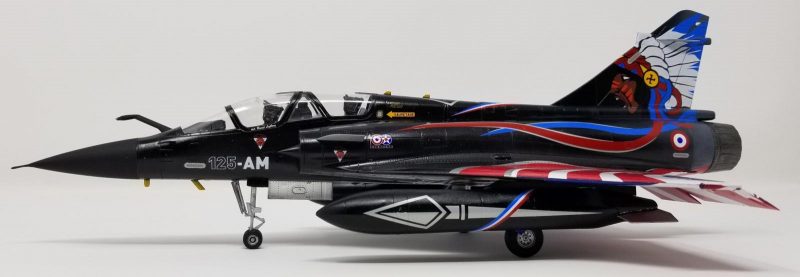

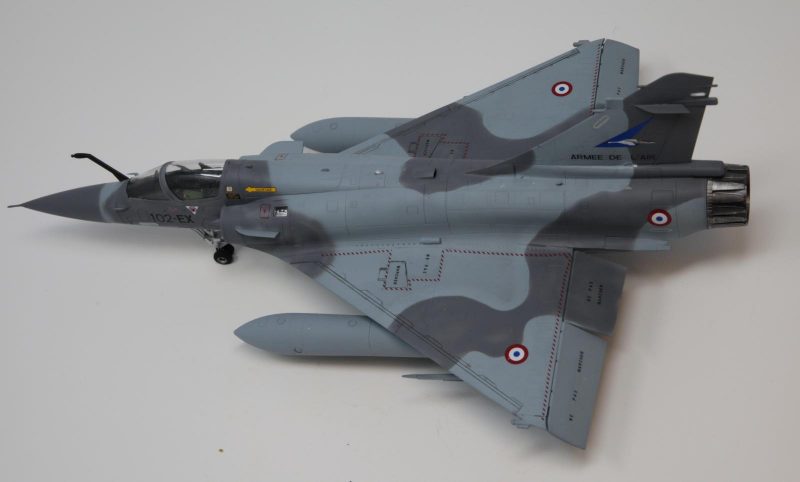
















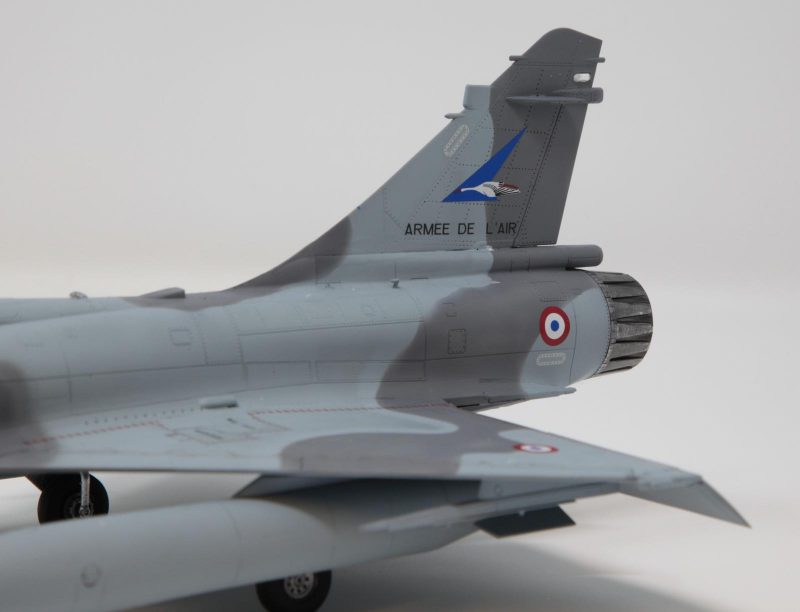







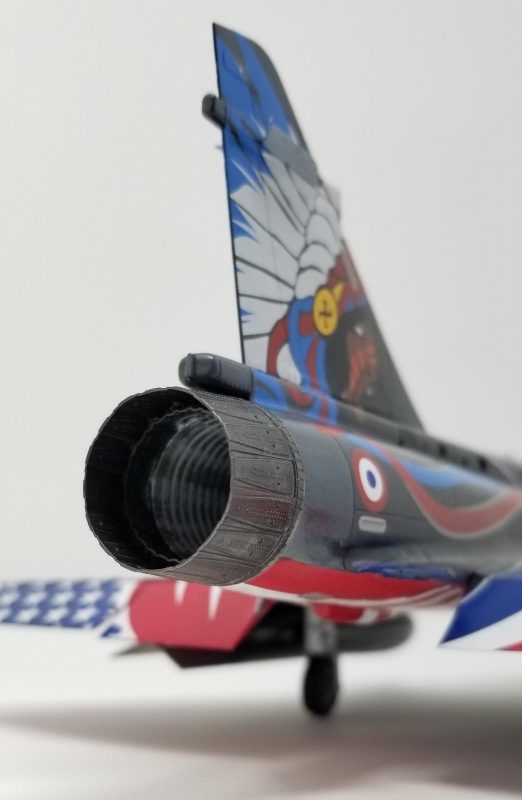

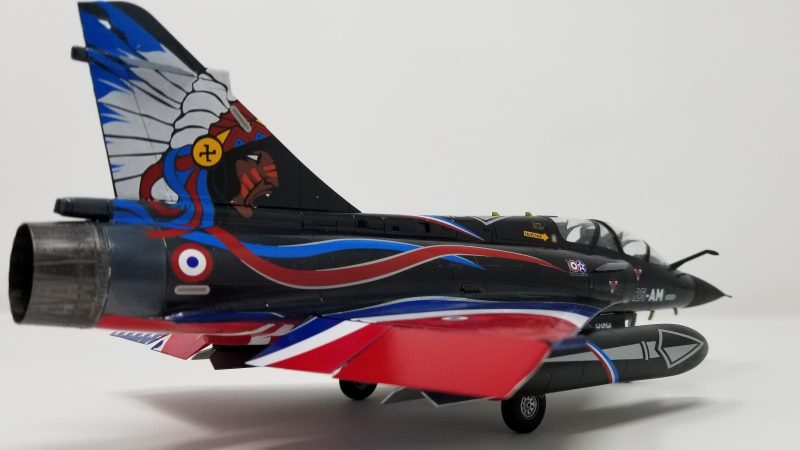


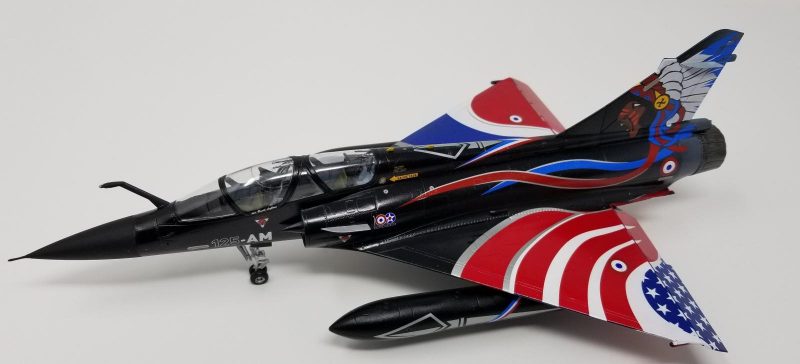



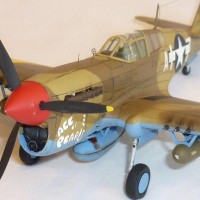
Not too sure where to begin on this, Wes. Your painstaking attention to detail and research, together with your excellent modelling skills, have resulted in two excellent models. Definitely liked.
Although you faced a lot of issues on these two kits, you have created two outstanding looking models, Wes.
It clearly shows your modelling skills.
The 2000D scheme is fantastic.
Wes, you did a SPECTACULAR job on both Mirage 2000s!
Your attention to detail is among the best I've seen!
Equally amazing is your effort to address, fix and document all kit iasues.
This build article is a definite reference for anyone willing to tackle the Kinetic Mirage 2000.
Well done!
I would call these spectacular saves of dogmeat kits. Excellent work and the Lafayette Escadrilled farewell airplane is stupendous in its final result.
I have built the Kinetic 2 seat Harrier, and it was no problem and vastly superior to other Harrier kits out there. I hear very nice things about the new Pucara kit - from people who are pretty picky about things. The only nit anyone's been able to pick with it is it uses the wrong font for the Fuerza Aerea Argentina decals.
Your Mirage WIP shows how a bad kit can still be brought up to impressive results, and obviously choosing such a spectacular livery just raises it up even more. Like I said at your WIP, beautiful model Wes
These came out as immaculate builds, despite the kits! Excellent - I love the camo'd bird best as I'm less drawn to non-combat schemes, but both are excellently done (is that proper grammar?)!
I am not a Mirage expert by any stretch, but I had similar issues with the intakes and wing/fuselage join with the Kinetic Kfir. Same issue popped up with someone else building the Mirage 5. Something not quite right in that aspect for those Kinetic Mirages.
Excellent work on what I know is a difficult kit.
Despite the issues presented ... you have just done two of the best Mirages I have seen.
The Mirage itself is a very beautiful aircraft . Your commitment and perseverance has made you shine on these build, very good modeling Wes, this is very entertaining to see.
Thank you.
yeap, even the worse kit can be built to a gem.
Congratulations, I learned a lot and surely stay away from this one
cheers!
You're absolutely right. As far as I'm concerned, Kinetic kits are well below the standards, for a modern brand, regarding fitting, engineering and instructions for their kits. I had my share with these problems with a Mirage IIIE. My first and last Kinetic, at least until they improve them all.
Having said that, your work is also absolutely brilliant. Well done!
Perseverance paid off. They look great. Kinetic has improved by leaps and bounds. I have one of their older F-16s in the stash and it’s pretty rough. I’ve also built the TAV-8A kit and loved it. It was one of the best designed and pleasant modern jet kits that I’ve ever built.